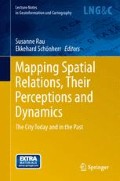Abstract
Various interpretations of Barcelona’s urban space are presented in this paper in connection with the city’s key structural changes during the early modern period. In line with certain utilitarian perspectives, the contemporary actors at various points in time came up with diverse models of spatial structurisation. In addition to the apparently natural division of Barcelona into two parts, an administrative division into four quarters had been established since the Middle Ages. However, this division was not directly linked to the pre-dominant, binary interpretation. Both in descriptions of the city by German speaking authors and in artistic depictions, binary structurisations of the city remained in the forefront. However, alongside the dominant perception of the city as being divided along the inner city wall and the Ramblas, alternative interpretations made their appearance, based on the old Roman city wall or the city’s later extensions. Modern maps of historical space should not depict merely established and pre-dominant interpretations, but their task is also to present alternative and minority structurisations. In addition, there is an indication in this process of the danger which is inherent in the mapping of urban spaces: complete mapping of the historical city often gives the impression that the whole of the city space is covered by our knowledge. We are, however, confronted with huge informational gaps as far as the historical general image of the city is concerned. This is because generally only a select number of building types are depicted or described, or, alternatively, these depictions and descriptions refer only to a narrowly defined area. This information gap should also be recognized in maps portraying the historical city. Just as the representation of our knowledge is essential, it is also equally important to represent our information gaps.
Access this chapter
Tax calculation will be finalised at checkout
Purchases are for personal use only
Notes
- 1.
In addition, the demographic trends analysed by Manel Guàrdia Bassols (see his contribution in the present volume), demonstrate the vitality of what had been assumed to be a stagnating city.
- 2.
Examples are: “It [Barcelona] is situated by the Mediterranean Sea and seems to be divided into two cities, one of which forms the inner city, which has high walls and four gates lead through these four walls corresponding to the four areas of the heavens and this part is called the Old Town. The other city is built around the Old Town and, likewise, has strong walls and solid towers and can be called the New Town.” (M. 1704: 461); “Actually, it [Barcelona] consists of three cities: the Old Town and the New Town, and the Barceloneta with its harbour. The New Town almost comprises the whole city as it encompasses the Old Town, whose walls are still completely intact in many places. The building of these walls is often attributed to the Romans because the Spaniards, who know very little about architecture and the Ancient World, ascribe everything to the Romans” (Loning 1844: 21).
- 3.
The references to various 19th century copies of 18th century military maps in this article are based on my own work at the AHCB—Arxiu Històric de la Ciutat de Barcelona, (the city’s administrative archives) to which the copies have been bequeathed. In addition, this also refers to Barcelona’s interest in its own history in the context of the Catalonian Renaixença, which was crucial for the production of these copies.
References
All maps by The Cartographic Institute of Catalonia (ICC—Institut Cartogràfic de Catalunya), Historic Archive of the City of Barcelona (AHCB—Arxiu Històric de la Ciutat de Barcelona) except Fig. 9 (by Wikimedia)
Brotons i Segarra R (2008) La ciutat captiva. Barcelona 1714–1860. Albertí, Barcelona
Busquets J (2004) Barcelona. La construcción urbanística de una ciudad compacta. Ediciones del Serbal, Barcelona
Centre de Cultura Contemporània de Barcelona, Institut Municipal d’història de Barcelona (eds) (1995) Retrat de Barcelona. Barcelona, (cit.: CCCB/IMhB 1995)
Galera M, Roca F, Tarragó S (1982) Atlas de Barcelona. Segles XVI–XX. La Gaya Ciencia, Barcelona
Garcia i Espuche A, Guàrdia i Bassols M (1986) Espai i societat a la Barcelona pre-industrial. Edicions de la Magrana, Barcelona
García Espuche A (1998) Un siglo decisivo. Barcelona y Cataluña 1550–1640. Alianza, Barcelona
Guàrdia M, Monclús FJ, Oyón JL (1994) Atlas histórico de ciudades europeas. Salvat, Barcelona
Loning A (1844) Das spanische Volk in seinen Ständen, Sitten und Gebräuchen mit Episoden aus dem carlistischen Erbfolge Kriege. Hahn, Hannover
M. J (1704) Der Schau-Platz von Spanien und Portugall, auf welchem Zweyen Absätzen bey einem jeden vorläufig die Staats- und Kriegs-Geschichte und dann die Beschreibung fast aller darinnen befindlichen Festungen und Plätze aufgeführt, mit Contrefaiten und wahren Grund-Rissen annehmlicher gemacht werden: Dem curieusen Leser zur Beurtheilung der Affairen dieser Zeit sehr dienlich. Leuther, Amsterdam
Montaner C, Nadal F (eds) (2010) Aproximacions a la història de la cartografia de Barcelona. Barcelona
Perelló Ferrer AM (1996) L’arquitectura civil del segle XVII a Barcelona. Publicacions de l’ Abadia de Montserrat, Barcelona
Vilar P (1973) Un moment critic en el creixement de Barcelona: 1774–1787. In: Vilar, Pierre. Assaigs sobre le Cataluña del segle XVIII, Curial, Barcelona, pp 43–55
Author information
Authors and Affiliations
Corresponding author
Editor information
Editors and Affiliations
Rights and permissions
Copyright information
© 2014 Springer International Publishing Switzerland
About this chapter
Cite this chapter
Schönherr, E. (2014). Elements of Historical Knowledge About Urban Spaces: Reflections on the Requirements for a Dynamic Map. In: Rau, S., Schönherr, E. (eds) Mapping Spatial Relations, Their Perceptions and Dynamics. Lecture Notes in Geoinformation and Cartography. Springer, Cham. https://doi.org/10.1007/978-3-319-00993-3_10
Download citation
DOI: https://doi.org/10.1007/978-3-319-00993-3_10
Published:
Publisher Name: Springer, Cham
Print ISBN: 978-3-319-00992-6
Online ISBN: 978-3-319-00993-3
eBook Packages: Earth and Environmental ScienceEarth and Environmental Science (R0)

